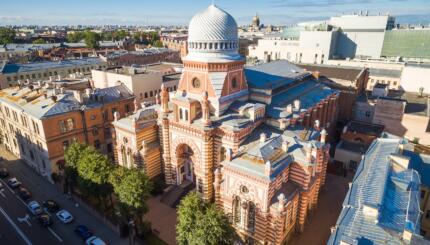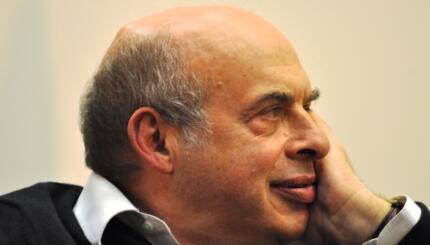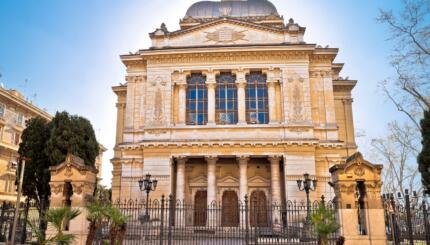In contemporary Jewish life, the word “interfaith” is usually coupled with the word “marriage.” However, the history of modern interfaith relations occupies a much broader plane, concerning itself with both private and public manifestations of religious tolerance and interaction between diverse religious groups. Over the course of the 20th century, interreligious dialogue has resulted in both fear and security, reinforcement of age-old values and lessons from new experiences.
The Interfaith Idea
The idea of interfaith dialogue and cooperation is rooted in the liberal fabric of modernity. The same modern, liberal philosophies that led to Jewish emancipation (civil rights) encouraged religious tolerance. If all citizens were to be equal before the law, as modern western governments decreed, then the state could and must support a diversity of beliefs and opinions. How diverse citizens interacted with each other and the state varied across time and place.
The Interfaith Movement
America in the 1920s proved the time and place for the beginning of the interfaith movement. This may seem incongruous to those students of American history who remember the intense isolationism and nativism that characterized America in the 1920s. The decade after World War I saw the passage the 1924 immigration act that severely limited access to the United States, the resurgence of the Ku Klux Klan, and the publication and dissemination by Henry Ford of The Protocols of the Elders of Zion, a forgery that alleged world Jewish conspiracy.
And yet the 1920s were also the “age of goodwill.” A sizeable number of American religious leaders judged the intolerance advocated by the KKK and others as un-American and un-Christian. In addition, WWI stimulated a sense of religious fraternity, as soldiers (and chaplains) of different faiths worked and fought side by side. Finally, many religious leaders realized that domestic harmony improved chances of more peaceful international relations.

Help us keep Jewish knowledge accessible to millions of people around the world.
Your donation to My Jewish Learning fuels endless journeys of Jewish discovery. With your help, My Jewish Learning can continue to provide nonstop opportunities for learning, connection and growth.
Interfaith activity in the past as well as today often centered around joint social-action or political advocacy projects. Protestant activists inaugurated this age of goodwill, coordinating efforts to improve industrial conditions, upgrade the quality of urban life, and foster international peace and justice.
The Federal Council of Churches (FCC) was the Protestant agency that coordinated interfaith activities. The FCC invited representatives from Jewish and Catholic groups to participate in FCC-sponsored social-justice and research projects. These efforts sparked interreligious dialogue that led to the formation of new organizations dedicated to combating prejudice and promoting inter-religious harmony, including the FCC’s Committee on Goodwill Between Jews and Christians, the Central Conference of American Rabbis Committee on Goodwill, the American Goodwill Union, and, finally, in 1927, the formation of an organization that continues to work toward community and justice to this day, the National Conference of Christians and Jews (NCCJ).
The NCCJ quickly became the largest and most active organizational arm of the interfaith movement. The NCCJ was known for its educational programs, the most famous of which were the “tolerance trios”–groups comprised of Protestant, Catholic, and Jewish clergy who traveled together to lecture on goodwill and understanding among faith groups.
The original tolerance trio consisted of Father John Elliott Ross, Rabbi Morris Lazaron, and Dr. Everett Clinchy. Together, they covered 9,000 miles, delivering their message of tolerance to 129 American audiences.
Jewish Reactions
Jews met the Protestant-driven interfaith movement with both hope and a healthy amount of skepticism. Rabbi Hyman Enelow, of Temple Emanu-El, capsulized Jewish fears about interfaith efforts in a 1927 letter: “There are so many committees coming into existence for the diffusion of goodwill that I hope [Jews] won’t be killed with kindness before the messiah has arrived.”
Was there a hidden Protestant missionary agenda behind interfaith? Were efforts toward cooperation really aimed at conversion? These were among Jews’ chief worries when it came to Protestant interfaith overtures.
Jewish motives were not to be taken for granted either. A radical Jewish subset of the interfaith movement advocated interfaith activity as the first step toward the establishment of a new universal religion.
In the end, however, the moderate and more popular view of interfaith affairs prevailed. With peaceful coexistence and cooperation as its goals, Jews joined the Protestants and Catholics in the NCCJ and other interfaith activities in large numbers. B’nai B’rith, the Union of American Hebrew Congregations, and the National Council of Jewish Women were just of few of the many Jewish organizations that organized goodwill committees and contributed supporting funds to the NCCJ.
In their contributions to the movement, Jews expressed commitment to religious tolerance, but their participation also served a more amorphous goal. By joining the two other major faith communities, Jews felt like an accepted partner in American culture.
The Movement Falters: The Holocaust
While the interfaith movement successfully promoted interfaith education through lectures and workshops in America, the movement failed to effect change when it mattered most–in the political arena during the reign of the Nazis.
The FCC and the NCCJ gave money, held rallies, wrote and signed statements of protest, and petitioned Congress and the president, but were ultimately unable to arouse significant Christian support on behalf of European Jewry.
The Holocaust changed the course if interfaith dialogue, shifting the focus from combating intolerance to understanding intolerance. How did anti-Jewish aspects of Christian theology encourage demonization of Jews? Where did these attitudes come from? Could they be changed, and if so, how? These are some of the philosophical questions that became part of interfaith dialogue in the postwar period, and they continue to be debated today.
The Movement Regains Momentum: The Postwar Period
Interfaith activities expanded in pluralistic postwar America. The civil rights movement provided opportunities to actualize interfaith goals of social justice. The NCCJ broadened its agenda to include race in the 1950s. By the 1960s, the group had implemented a national campaign–in conjunction with the Urban League, the American Jewish Committee, and the National Association for the Advancement of Colored People–to counter anti-Semitism and racism.
In the 1970s, the NCCJ led a nationwide series of interfaith institutes on the Holocaust. These institutes were instrumental in promoting national discussion of the Holocaust, a discussion that contributed to President Jimmy Carter’s decision to establish the United States Holocaust Memorial Council in 1978.
Rising rates of intermarriage have provided American religious communities a whole new class of interfaith issues, posing challenges of amity, peace, and justice on local and personal levels. Both families and synagogues face the challenges implicit in nurturing Jewish identity within the context of interfaith marriage. What is fair? welcoming? alienating? How do community leaders and families address the fear, guilt, and anxiety that interfaith relationships can cause in their extended families and communities? What about those who believe that intermarriage is a triumph of American tolerance and equality?
Navigating the issues of fairness, friendliness, and fraternity have been goals for the larger interfaith movement since its inception. With the rise of intermarriage, this quest is just as likely to play out in living rooms as it is in lecture halls.



